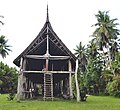This article needs additional citations for verification .(February 2022) |

Haus Tambaran is a Tok Pisin phrase which describes a type of traditional ancestral worship house in the East Sepik region of Papua New Guinea. The most visually recognizable forms are from the Maprik area, with a tall and elaborately decorated front entrance wall where the ridge pole slopes down low toward the back of the building and the roof follows this decline and often continues all the way to the ground. The Sepik people are renowned for their superb artistic ability in painting and carving, which is often exhibited in these religious structures.
Contents

The front entrance of the modern National Parliament (which is sometimes referred to informally as Haus Tambaran) building in Port Moresby is modelled on traditional haus tambaran architecture. [1] : 179 It can be viewed on Google Earth at Latitude: 9°25'41.69"S, Longitude: 147°11'33.45"E, and is depicted on the Papua New Guinea 50 Kina note. The High Commission of Papua New Guinea in Canberra, Australia, is also influenced by haus tambaran.
Haus Tambaran have become less common as Christian fundamentalism has increased. [1] : 183







